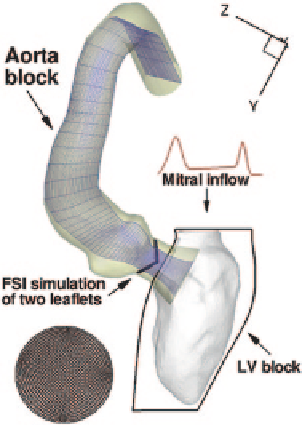Biomedical Engineering Reference
In-Depth Information
9.6
Advanced Heart Valve Modelling
Advanced modelling techniques have allowed researchers to investigate the fluid
and structural dynamics of the heart and heart valve. This section we summarise the
latest advanced research outcomes from this field.
Yun et al. (2014) investigated the flow dynamics for pulsatile flow through bi-
leaflet mechanical heart valves. The Lattice-Boltzmann method was used to simu-
late a pulsatile, high-Reynolds-number flow with the inclusion of reverse leakage
flow through prosthetic devices. The flowrate and leaflet motion were derived from
experimental data. Comparison of the numerical simulations with experimental
digital particle image velocimetry (DPIV) showed good validation quantitatively
as well as qualitatively.
Le and Sotiropoulos (2013) developed a large scale kinematic model for animat-
ing the left ventricle wall and used this model to drive the fluid-structure interac-
tion between blood flow and a mechanical heart valve prosthesis (Fig.
9.9
). The
kinematic model simulated the left ventricle wall motion in response to an excita-
tion wavefront propagating along the heart wall. The large-scale left ventricle wall
motion exhibits complex contractile mechanisms that include contraction (twist)
and expansion (untwist). The fluid-structure interaction between the leaflets of the
mechanical heart valve and the blood flow driven by the dynamic left ventricle wall
motion and mitral inflow is simulated using the curvilinear immersed boundary
method and implemented in conjunction with a domain decomposition approach.
Similar work include Borazani (2013) who coupled a sharp-interface immersed
boundary incompressible Navier-Stokes solver for the fluid domain with a non-
Fig. 9.9
Computational grid
of the left ventricle block and
the aorta block. The left ven-
tricular block is a structured
grid of size 161 × 281 × 161.
The aorta block is a
body fitted mesh of size
161 × 161 × 401. At the mitral
position, uniform pulsatile
flow is specified as boundary
condition and the mitral valve
is assumed to be fully open
during diastole. (Image from
Le and Sotiropoulos 2013)

Search WWH ::

Custom Search